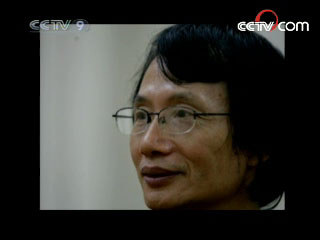------Program code: DO-080707-00851 (what's this?)
Source: CCTV.com
07-07-2008 08:28
Zhu Daoping was born in 1949 in Huangyan, Zhejiang Province, a place famous for producing talented people. His grandfather was a scholar under the Qing Dynasty, and his father was a famous garden designer.
 |
So Zhu Daoping was born with a natural artistic talent. During the Cultural Revolution, he had to do farm work during the daytime, but he spent the nights painting. Despite his youth, his traditional painting “After Night School” was sent to a national exhibition, together with works by a number of professional painters.
This caused a sensation at the time. After studying Art at Nanjing Academy of Arts, Zhu Daoping fell in love and married. His wife was also from an artistic family. Her father was the famous oil painter Su Tianci, her mother was a sculptor, and she herself is now an associate professor of design at the Nanjing Academy of Arts.
 |
When he was very young, Zhu Daoping and his parents moved to Nanjing, the ancient capital that used to be known as Jinling. They lived on the shore of Xuanwu Lake, east of Jilong Mountain. As a boy, he and his friends often climbed the mountain to gaze at the lake through the mist.
The beautiful scenery of the lake and mountain inspired him as an artist. 20 years later, Zhu Daoping is now a Chinese landscape painter, president of the Nanjing Academy of Calligraphy and Painting, and chairman of the Nanjing Art Association. His office happens to be located on the island that he and his friends used to look down on. Zhu Daoping retains many beautiful memories of the wonderful scenery of the lake.
In 1980, Zhu Daoping was assigned to work at the Nanjing Academy of Calligraphy and Painting. It was a good opportunity for him to research traditional Chinese painting. From Fu Baoshi and Huang Binhong, to Shi Tao, Mei Qing, Wang Meng and Dong Yuan, he learned a lot about traditional Chinese painting. Meanwhile, he regularly went out sketching, so as to seek inspiration from nature. Gradually, he was escaping from the restrictions of tradition and beginning to express his own mind. Mostly he paints in a quiet and cheerful mood. While he’s painting, he likes to listen to music. This makes him more active and his brushwork more melodious. As a result, his painting becomes livelier.
In Chinese painting, a major focus is the lingering charm of the brushwork, the excellence of the artistic conception and the refinement of the taste. Concentration is essential to achieve all this. A painting is the product of the painter’s emotions. In view of this,
Zhu Daoping observes a simple motto: “Never to paint if not interested and never to paint when not in the mood.” Another maxim he abides by is that every painter has his unique appreciation of life, and so he should choose what impresses him most, paint it the best he can and so create his own style. Zhu himself takes full advantage of his style and takes it to the height of perfection, with the result that his work always has strong artistic appeal. His paintings can be likened to the lingering ballads of the south, refreshing and poetic. Undoubtedly, his art is closely associated with southern China, but more its culture than its geography.
Zhu Daoping’s paintings are reminiscent of a short poem. A light rain shrouds the bleak forest; a wild goose is crying far away on the river, and meanwhile I am drinking and singing alone.
At the back of the yard, the rustle of the falling maple leaves disturbs the sound of the zither. The scene, though imaginary, seems very attractive. At their highest level, Chinese poetry and painting are similar; a lot in a little, natural but charming. Zhu Daoping’s paintings are instinctively associated with the elegance, grace, and rustic charm of southern China. Today, however, amid the fickle modern society and popular fast-food culture, people are losing such subtle sentiments and adopting more superficial behaviour.
In such a situation, the works of Zhu Daoping are like a limpid pond amid gorgeous autumn scenery, providing rare delight. Greatness and magnificence are not the whole of art; another aspect is the exquisiteness of southern China, built on its history.
Trees are dominant in Zhu Daoping’s paintings. But his trees are different; their various characters, against the background of the seasons, make the landscape active and vigorous. Zhu Daoping prefers autumn trees; creating great charm out of the fallen leaves, set against the green mountains and limpid rivers.
Unlike the grand mountains of northern China, or the aloof landscapes of Ni Yunlin, the works of Zhu Daoping are elegant and friendly. The essence of southern China’s culture is incorporated into his paintings. He is not painting a particular mountain or forest, but his own experience of south China’s culture and history.
So, the connotation and attributes of culture are included in Zhu Daoping’s landscape paintings. In the 1990s, his paintings started getting purer and freer. He encodes natural space and time and decodes it with his heart and spirit. By doing so, Zhu Daoping compresses a real landscape into a plane interwoven both rationally and sensitively, by dots and lines.
